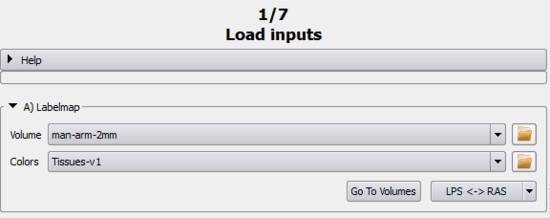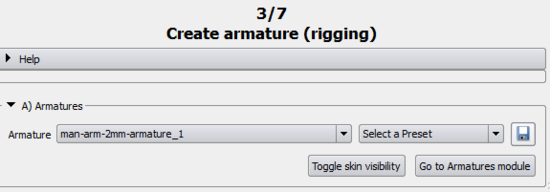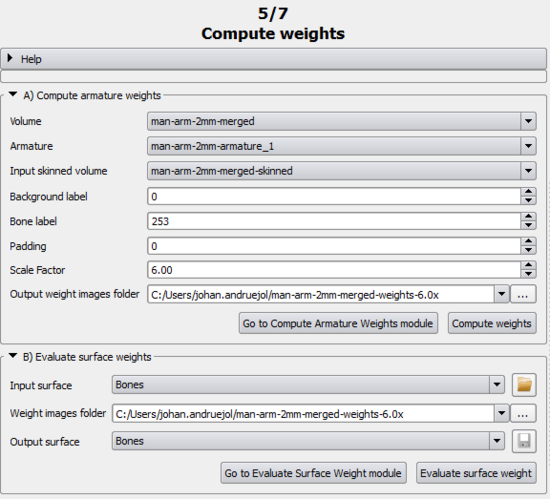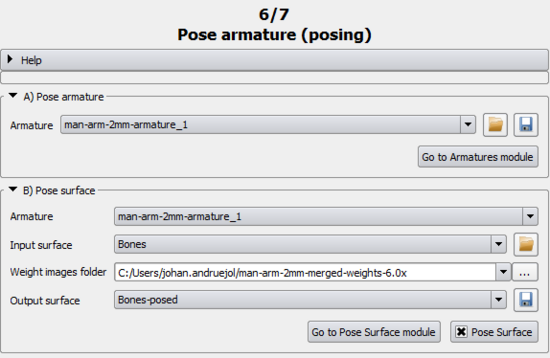Introduction
This module guides the user step-by-step into transforming a volume using a rigging, skinning and posing technique.
Details
Author: Julien Finet, Kitware
Contributor #1: Johan Andruejol, Kitware
Acknowledgements: This work is supported by the Air Force Research Laboratories.
Contact: Julien Finet
Use Cases
2mm labelmap volume loaded in workflow
Bone and Skin surfaces extracted from 2mm labelmap volume
Parameters
Advanced properties
- Advanced Workflow: Show/Hide advanced controls at each step of the workflow.
- Advanced properties are automatically set by the workflow logic for a "standard" processing. Nonetheless it is possible for the user to tweak those parameters.
- Note that all the parameters are not exposed even in "Advanced Workflow" mode. The full list of parameters is available in the specific module panels that can be opened by clicking the "Go to XYZ" buttons.
Volume Render
- Labelmap: Select the volume/labelmap you want to volume render. The checkbox next to labelmap controls whether the rendering is visible or not.
- Label(s): List all the label(s) that should be visible (i.e. opacity > 0.), all the other labels will be hidden (i.e. opacity = 0.). Labels must be separated with a ',' (comma).
- Go To Volume Rendering: Opens the Volume Rendering module. It gives full control over the volume rendering parameters such as the color and opacity transfer functions, shading, rendering quality...
|
 Advanced properties panel |
1) Adjust Labelmap
A) Labelmap
Simple workflow
- Volume: Select the volume/labelmap that you want to reposition. Read here the instructions to load data into Bender.
- Colors: Select the color transfer function to apply to the volume . It will The transfer function is used to
- Apply: Set the color transfer function to the volume.
- LPS<->RAS: Apply a (-1,-1, 1) transform to the volume. It can be used to apply the same coordinate system used by Bender to the volume. The "R,L,A,P,S,I" letters on the purple box in the 3D view represent the orientations "Right, Left, Anterior, Posterior, Superior, Inferior".
Advanced workflow
- Go To Volumes: Go to the Volumes module to read volume information (such as its size, origin, spacing, scalar type, range...) and display properties (window/level, threshold, interpolation...)
B) Merge labels
Simple workflow
- Output Labelmap: Select the labelmap for which the labels will be merged together.
- Merge labels: Merge the Bone Label(s) and Skin Label(s) from Input Labelmap (into respectively Bone Label and Skin Label) and outputs the result in Output Labelmap. This allows to extract or visualize the Bone Model and the Skin Model (see 2) Extract Bone and Skin) more easily.
Advanced workflow
- Input Labelmap: Select the labelmap that needs label to be merge together. Set by default to the selected volume in A) Labelmap.
- Bone label(s): Choose the label(s) that will be merge into the Bone Label. They are automatically computed based on the input volume color table by looking for names containing "bone" and "vertebrae" in it.
- Bone label: Select the new label value of the Bone Label(s).
- Skin label(s): Choose the label(s) that will be merge into the Skin Label. They are automatically computed based on the input volume color table by looking for names containing "skin" in it.
- Bone label: Select the new label value of the Skin Label(s).
- Go To Change Label: Opens the Change Label CLI.
|
|
2) Extract Bone and Skin
A) Bone Model Maker
Simple workflow
- Output model hierarchy: Select the output model hierarchy under which the bone model will be stored.
- Generate bone model: Using the Model Maker, generate the bone model. The bone model will be used when placing the armature. It allows to place the armature bones on top the real bones for a better and more natural posing.
Advanced workflow
- Label(s): Select the label that will be used to create the bone model. By default, it automatically uses the label from Bone Label (in 1) A)).
- Go To Models: Opens the Models module.
- Go To Model Maker: Opens the Models module.
B) Skin model maker
Simple workflow
- Output: Select the output model for the skin model.
- Toggle skin visibility: Toggle the visibility of the model selected in Output.
- Generate skin model: Using the Grayscale Model Maker, extract the outer surface of the Input Labelmap. The skin model can be used to help find the right pose with no overlaps by using the 5) Pose Armature(posing).
Advanced workflow
- Input Labelmap: Select the labelmap that will be used to create the skin model.
- Threshold: Select the threshold that will be used to differentiate the body in the labelmap from the outside (usually air). Default is 0.1.
- Go To Models: Opens the Models module.
- Go To Grayscale Model Maker:Opens the Grayscale Model Maker module.
|
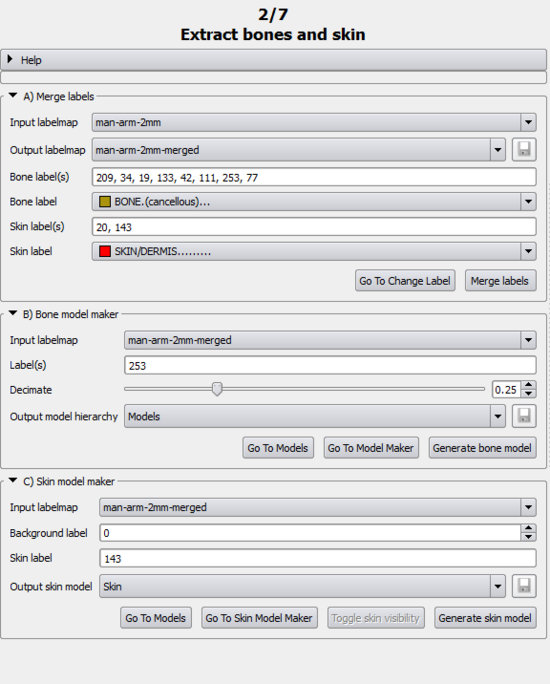 Extract bone and skin panel |
3) Create armature (rigging)
A) Armatures
When opening this page, the view will automatically switch to 3D Only to help creating/visualizing the armature.
The armature (either created or loaded) is the interface between the user and the transformations needed to pose the volume models. Once completed, the armature rest positions should not be changed since it would necessitate all the following computation to be updated as well. It is therefore highly encouraged to save the created armature in order to be able to restore it with Load armature from model.
Simple workflow
- Toggle Skin visibility: Does the same as Toggle Skin Visibility in 2) B). It is advised to turn off the skin visibility so when placing bone, they automatically will drop at the same depth as the skeleton model instead of the skin model.
- Load armature from model: Prompts a dialog window to open an armature from a model. See Armature Module for further details.
- Go To Armature Module: Opens the Armature Module.
|
|
4) Compute weights (skinning)
|
When opening this page, the view will automatically switch to Four Up.
A) Volume Skinning
Simple workflow
- Volume: Select the volume/labelmap that will be used for the skinning.
- Armature: Select the armature associated with the Volume.
- Output skinned volume: Select the output volume.
- Skin volume: Compute the skinned volume. The output skinned volume is a labelmap where each voxel of the input Volume is associated with a bone of the input Armature. This means that if we were to use binary weights, a given voxel will move exactly as its associated bone in the skinned volume. For this reason and as the skinned volume drives the weight computation, it can be very profitable to tweak this results, most notably in joints area.
Advanced workflow
A) Compute Armature Weight
Simple workflow
- Output weight image folder: Select the folder where the weight images will be saved.
- Compute weights: Compute the weight image. For each bone of the Armature a weight image is created. A weight image stores by how much a given voxel of the Volume will be influenced when the associated bone moves. This computation is based on the solving of a heat-diffusion equation for which the bones of the volume represent the hot source.
Advanced workflow
- Volume: Select the volume/labelmap that will be used for the weight computation. It should be the that was used for the A) Volume Skinning.
- Armature: Select the armature associated with the Volume. It should be the that was used for the A) Volume Skinning.
- Input skinned volume: Select the skinned volume. It should be the (possibly tweaked) volume associated with the Volume and the Armature.
- Go To Compute Armature Weights Module: Opens the Compute Armature Weight module.
|
|
5) Pose armature (posing)
|
When opening this page, the current armature (if any) will automatically switch to Pose mode.
A) Evaluate Surface Weight
Simple workflow
- Output surface: Select the output surface with the weight evaluated for each of its points.
- Evaluate surface weight: For each point of the Input Surface, evaluates of the influence of all weight and add it as a field array. This will improve the computationnal time of the Pose Surface.
Advanced workflow
- Input surface: Select the input surface that will have the weight evaluated on.
- Weight images folder: Select the folder where the weight images are.
- Go To Evaluate Surface Weight Module: Opens the Evaluate Weight module.
A) Armatures
Simple workflow
- Go Armature Module: Opens the Armature module.
A) Pose Surface
Simple workflow
- Output surface: Select the output surface that will store the posed Input Surface.
- Pose surface: This will pose the Input Surface according to the posed Armature and the weight images from the given Weight images folder. If the surface was evaluated, this will automatically use the evaluated weight to compute the posed surface. If not it will read the weight from the Weight images folder to do so (slower). If the checkbox is activated, the CLI will automatically run anytime any of the input is modified. Otherwise, the CLI will only run once.
Advanced workflow
- Armature: Select the posed input armature.
- Input surface: Select the input surface that will be posed.
- Weight images folder: Select the folder where the weight images are.
- Go To Pose Surface Module: Opens the Pose Surface module.
|
|
6) Pose labelmap
A) Resample labelmap with pose
Simple workflow
- Output posed labeldmap: Select the output labelmap that will store the posed Input labelmap.
- Apply: This will pose the Input labelmap according to the posed Armature and the weight images from the given Weight images folder.
Advanced workflow
- Armature: Select the posed input armature.
- Input surface: Select the input labelmap that will be posed.
- Weight images folder: Select the folder where the weight images are.
- Go To Pose Labelmap Module: Opens the Pose Labelmap module.
|
|
Developer Information





